Guide to Cognitive Ability Tests
Table of Contents
Introduction
Cognitive ability tests are a category of psychometric assessments designed to measure your general intelligence. These tests typically consist of multiple-choice question sets.
Because there are many commercially available assessments in this category (commonly purchased by employers and classified as “cognitive ability tests”), this guide provides a comprehensive overview based on the most widely used versions.
Take the time to read through the information we’ve compiled—it’s designed to help you understand how these tests work, how to tackle the questions effectively, and how to boost your score during the hiring process.
If you’re looking for a broader overview of all types of aptitude tests used by companies and organizations during recruitment, check out our Practical Guide to Aptitude Tests: A General Overview of all Test Types. You’ll find detailed explanations, examples, and strategies for answering the most common types of numerical, logical, abstract, and verbal questions.
To further enhance your preparation, you can also access our free Aptitude Test Simulator. This platform draws from a pool of over 11,000 questions commonly found in the assessments used by employers and agencies to select new talent.
100% Free. No Registration Required.
What Is a Cognitive Ability Test?
Cognitive ability tests typically combine verbal, numerical, abstract, and logical reasoning sections. Their complexity and difficulty can vary significantly—not only depending on the role a company is hiring for, but also between the different commercially available tests that fall under this category.
To summarize, here are five features commonly shared by most cognitive ability tests:
- They cover multiple “topics,” and the questions are usually mixed together, forcing the test-taker to constantly shift modes of thinking.
- A single question may involve more than one type of reasoning (for example, combining numerical and inductive reasoning).
- Many questions come with very tight time limits.
- Candidates are not expected to complete the entire test.
- While the questions themselves are not necessarily difficult, the time pressure and constant switching between different types of problems can make the test challenging.
Keep in mind that cognitive ability tests are just one type of aptitude test. For a broader overview of the most common assessments you might face during a recruitment process, be sure to check out our Practical Guide to Aptitude Tests: A General Overview of all Test Types.
100% Free. No Registration Required.
Topics Covered in Cognitive Ability Tests
1) Logical Reasoning
Logical reasoning questions in cognitive ability tests typically fall into three categories:
- Syllogisms: A form of reasoning that draws a conclusion from a set of premises explicitly stated in the question.
- Deductions and Inductions: Similar to syllogisms, but in reverse. These require using logical thinking to infer the information needed to reach a conclusion.
- Sequencing: liste di elementi di cui determinare l’ordine nel rispetto di un determinato insieme di regole esplicitate nel quesito.
2) Abstract Reasoning
Abstract reasoning questions in cognitive ability tests generally include these four types:
- Odd One Out: Identify the item that doesn’t belong in a given set (e.g., a group of words, images, or statements).
- Image Sequences: Identify the rule behind a progression of images—each one slightly modified from the previous—and determine the image that completes the series.
- Image Matrices: Similar to image sequences, but the images are arranged in a two-dimensional matrix instead of a linear progression.
- Image Analogies: Given a pair of shapes, determine the relationship between them and apply the same relationship to another pair.
3) Numerical Reasoning
Numerical reasoning questions in these tests typically include the following:
- Basic Math: Involves operations such as addition, subtraction, multiplication, division, fractions, averages, and ratios.
- Word Problems: Math problems presented as short narratives, requiring you to extract data and perform the correct operations to find a solution.
- Number Series: Determine one or more missing numbers in a sequence based on an implicit rule that governs the pattern.
4) Verbal Reasoning
Verbal reasoning questions often focus on these two areas:
- Vocabulary: Demonstrate understanding of a word’s meaning (primary or secondary) by selecting or using it correctly.
- Word Analogies: Identify the relationship between a given pair of words and apply that same logic to complete a second pair.
100% Free. No Registration Required.
Sample Questions from Cognitive Ability Tests
Syllogisms
- Question 1 with solution
Given the following statements: “If Mario is in New York, then Peter is in Chicago. Therefore, Peter is in Chicago.” Which of the following is true?
A) Mario is in New York
B) No logically valid conclusion can be drawn
C) Peter is in Chicago
- Question 2 with solution
If it is true that “not all misfortunes come to harm,” which of the following must also be true?
A) Some misfortunes do not come to harm
B) Misfortunes are not harmful
C) Things that cause harm are not misfortun
Deductions and Inductions
- Question 1 with solution
“If someone scolds Michael, he gets offended. But if no one scolds Michael, then Robert gets upset. Yesterday, Michael did not get offended.”
If the above statements are true, what can we logically conclude about yesterday?
A) Michael wasn’t scolded and Robert didn’t get upset
B) Michael was scolded and Robert got upset
C) Robert got upset
D) Michael was scolded and Robert didn’t get upset
E) Michael wasn’t offended, but he might have been scolded anyway
- Question 2 with solution
There are two types of reasoning: deductive and inductive. How many of the following different arguments are DEDUCTIVE?
Reasoning 1: People who think they can judge others are foolish; Manuela constantly judges her friends; therefore, it cannot be said that Manuela is intelligent.
Reasoning 2: All the dogs I’ve owned had an excellent sense of smell; Cetto, my grandfather’s dog, is great at finding truffles; Sibilla, my aunt’s poodle, always finds the hidden candy in the yard; dogs have an extraordinary sense of smell.
Reasoning 3: I bet on ten and lost; I bet on thirty and lost; I bet on two and lost; I must not be lucky in games.
Reasoning 4: Everyone preparing to visit a foreign country would do well to learn about its customs; Michele has been planning a trip to Indonesia for two months, so he shouldn’t forget to learn about Indonesian table etiquette.
A) All of them
B) Three
C) Two
D) One
E) None
100% Free. No Registration Required.
Sequencing
- Question 1 with solution
On a certain planet, there are three people: Anthony, Mark, and John. One of them is wealthier than both of the others. Mark is richer than Anthony. Anthony is poorer than John. Which of the following statements is definitely FALSE?
A) Anthony is the poorest
B) John is the richest
C) John is poorer than Mark
D) Mark and John have the same amount of money
E) Mark is the richest
Odd One Out
- Question 1 with solution

Which of the following figures—A, B, or C—should be eliminated as it does not belong in the group?
A) Figure A
B) Figure B
C) Figure C
- Question 2 with solution
Identify the odd word out::
A) Monk
B) Mountain
C) Monster
100% Free. No Registration Required.
Serie di immagini
- Question 1 with solution

Which image completes the sequence?

- Question 2 with solution

Which image completes the sequence?

Image Matrices
- Question 1 with solution
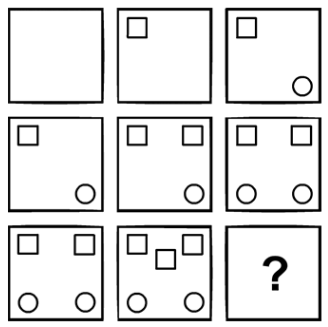
Select the option that completes the matrix:
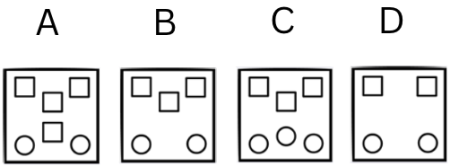
- Question 2 with solution
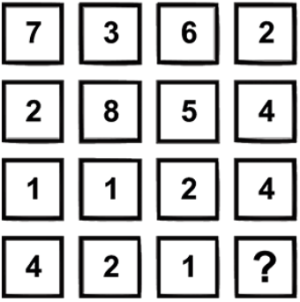
Which of the following options completes the matrix?
A) The answer is 1
B) The answer is 7
C) The answer is 4
D) The answer is 2
100% Free. No Registration Required.
Image Analogies
- Question 1 with solution
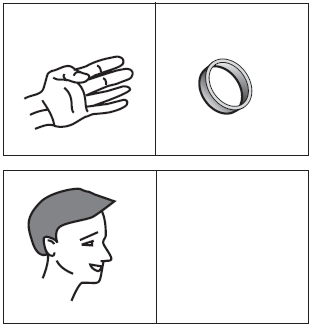
Which of the following options best completes the analogy?
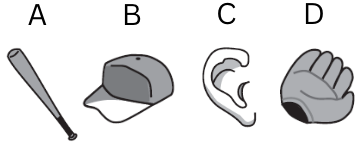
- Question 2 with solution

Which of the following options best completes the analogy?
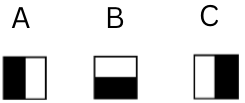
Math Skills
In addition to basic arithmetic, these questions may include: ratios, percentages, averages, unit and currency conversions, geometry.
- Question 1 with solution
Due to an increase in sales tax on electronics, the price of a 46-inch LED TV has risen to $845, which is 30% more than its previous price. What was the price of the TV before the increase?
A) $515.45
B) $591.50
C) $650
D) $676
E) $768.95
- Question 2 with solution
Alex and Rachel are avid car collectors. Their collections consist solely of German and Japanese cars.
In Alex’s collection, the ratio of German to Japanese cars is 5:2, favoring German models. In Rachel’s collection, the ratio is 4:3, also favoring German models. The number of Japanese cars owned by Alex is the same as the number owned by Rachel. What is the ratio of the total number of cars in Alex’s collection to the total in Rachel’s?
A) 15:8
B) 9:7
C) 1:1
D) 3:2
100% Free. No Registration Required.
Word Problems
Word problems describe a short scenario in which a mathematical calculation is needed to solve a real-life situation.
These types of questions—often involving work, travel, and rate-time relationships—are commonly found in tests like:
- CCAT (Criteria Cognitive Aptitude Test)
- PI Cognitive Assesmen
- McQuaig Mental Agility Test (MMAT)
- Cubiks Logiks
- Question 1 with solution
A post office receives one package every 3 minutes, and the delivery worker delivers 12 packages per hour. If the delivery starts at 8:00 AM and no packages were left over from the previous day, how long will it take for exactly 100 packages to accumulate at the post office?
A) 50 minutes
B) 3 hours and 20 minutes
C) 6 hours and 40 minutes
D) 10 hours and 50 minutes
E) 12 hours and 30 minutes
- Question 2 with solution
Emma and her parents are walking down the street. Her parents walk at a pace of 80 steps per minute. Her father is 12 steps ahead of her mother. Emma walks behind them at a pace of 90 steps per minute. The average step length is the same for everyone. How many seconds pass between the moment Emma catches up to her mother and the moment she catches up to her father?
A) 8 seconds
B) 12 seconds
C) 28 seconds
D) 72 seconds
E) 82 seconds
100% Free. No Registration Required.
Number Series
Number series questions present sequences of numbers called “terms,” each of which follows a logical arithmetic rule. Your task is to identify the missing number in the sequence. These questions increase in difficulty as the patterns become less obvious, requiring careful attention and creative thinking.
Such questions frequently appear on:
- CCAT (Criteria Cognitive Aptitude Test)
- PI assesment cognitivo
- McQuaig Mental Agility Test (MMAT)
- Logik Cubes
- Question 1 with solution
3 | 8 | 15 | 24 | 35 | ?
A) 42
B) 36
C) 48
D) 46
- Question 2 with solution
3 | 3 | 3 | 6 | 3 | 9 | 3 | ?
A) 3
B) 27
C) 12
D) 6
100% Free. No Registration Required.
Vocabulary
- Question 1 with solution
Which word is closest in meaning to elated?
A) anxious
B) confused
C) thrilled
D) indifferent
E) bored
Word Analogies
- Question 1 with solution
BIRD is to NEST as:
A) fish is to water
B) lion is to roar
C) bee is to hive
D) tree is to leaf
E) spider is to web
List of Major Cognitive Ability Tests
We’ve compiled this guide to help you understand the structure, format, and difficulty level of the most commonly used cognitive ability tests. The goal is to help you build an efficient study plan and improve your skills quickly and effectively.
For completeness, here’s a list of the most widely used and licensed cognitive tests—either directly by companies or indirectly through recruitment platforms. These are frequently used for pre-employment screening during the hiring process:
- Wonderlic Personnel Test (WPT)
- Thomas International GIA Test
- SHL Numerical Test
- McQuaig MMAT
- Revelian Cognitive Ability Tests
- PLI Test
- Cubiks Logiks
- Watson-Glaser
- Hogan HBRI
- Talent-Q Korn
- FerryCut-e Test
- Criteria Cognitive Aptitude Test (CCAT)
How to Prepare for Your Test in a Week or Less
If you’re short on time, it’s essential to use your study time wisely and strategically.
The ideal situation is that you already know which test you’ll be taking—such as the Talent Q by Korn Ferry, Cubiks Logiks, or similar. But even if you don’t, don’t worry. As we’ve explained, most aptitude tests are built on the same core principles and test similar types of reasoning.
If you commit to practicing this week—perhaps using our aptitude test simulator—instead of going out with friends, you’re very likely to see real improvement.
The key is making smart choices about how you spend your time. That means focusing your practice on the types of questions that match your actual test and zeroing in on the areas where you feel weakest. This is the core of an effective, personalized strategy.
Otherwise, you risk spreading yourself too thin—reviewing every topic without getting strong in the areas that will really boost your score.
With the resources on these pages, you can save time, avoid wasting money, and get better results. The choice is yours.
100% Free. No Registration Required.
One Last Tip
For a comprehensive overview of the different types of aptitude tests used by companies and organizations during the hiring process, check out our Practical Guide to Aptitude Tests: A General Overview of all Test Types. Inside, you’ll find clear explanations, examples, and step-by-step strategies for solving the most common question types—whether they’re numerical, logical, abstract, or verbal.
